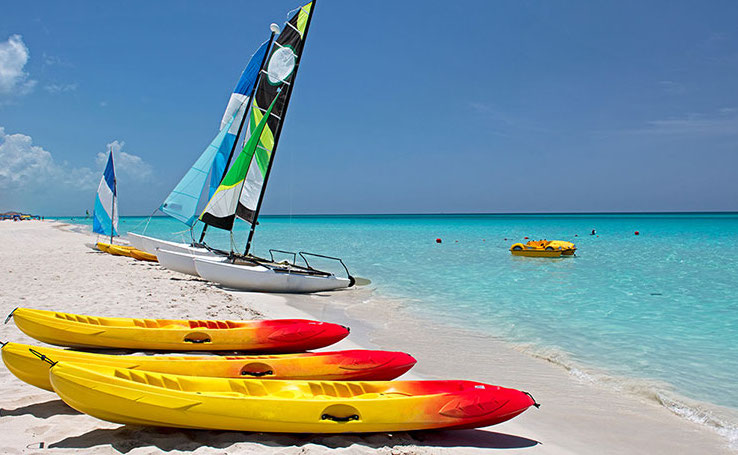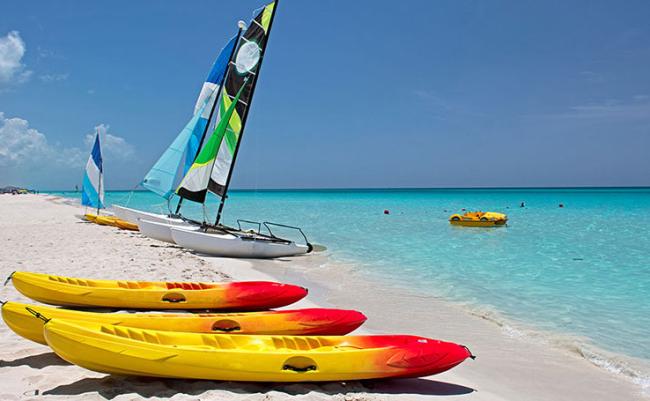Jet Blue Airways airline filed a request a few days ago with the US Department of Transportation to increase its daily flights from Miami to Havana, as it aims to compete with American Airlines (AA) to cover the 20 daily flights on the route authorized by the US authority.
It should be noted that what we are talking about here are, basically, Cubans residing in the United States who travel to the island to see their families and bring them what they need so that they don't go hungry or die due to a lack of medicine. Thus, this is a kind of tourism with a "ceiling," and not a very high one (several hundred thousand visitors), and one that cannot grow indefinitely to provide the millions of international vacationers that the regime wants to attract now that tourism "is recovering," as Prime Minister Manuel Marrero claimed, without blushing.
Recovering? Let's take a look at this. The hotel occupancy rate in Cuba in the first half of 2022 was 14.4%, according to the National Bureau of Statistics and Information (ONEI). In the first seven months of 2022, only 834,821 visitors reached the island ― barely 33% of the 2.5 million that the dictatorship had hoped (a pure fantasy) to welcome this year.
In the same period, from January to July 2022, neighboring Dominican Republic received 4,182,000 tourists, five times more than Cuba, despite being less than half its size (44%). In July alone the nearby nation welcomed 735,064 visitors, almost as many as Cuba did in the first seven months of the year.
Not only are those Cuban figures paltry compared to those of its competitors in the coveted Caribbean region, but Cuba is no longer even on the main international list of countries mentioned or recommended for tourism.
That is, Cuba no longer ranks internationally as a top tourist destination
In July of 2022 Cuba was conspicuously absent from the Travelers′ Choice awards, issued very year by the ultra-important international travel site TripAdvisor, as the island did not make the much-prized tourism promotion list published by said company, the largest of its kind.
At the beginning of the year, in the suggestions for 2022, Cuba had already been left out, not being included on the list released in Boston by Steven Paganelli, TripAdvisor's Director of Destinations and Hotels. At the beginning of each year, the tourism destinations that receive the most positive reviews from travellers are spotlighted on their website. For the 2022 list, 988 million opinions were received from eight million travel agencies and hundreds of millions of tourists, individually.
No hotel in Cuba managed to make the Travelers’ Choice list. Worst of all is that even Varadero, long the jewel in the crown of Cuban tourism, was also left off the list.
The famous blue Cuban beach did garner praise as the world's second most "ideal beach" for its extraordinary beauty, but it did not even appear in the "Most popular destinations for sun lovers" category, which is the one that counts, as it means profits.
Obviously, the criteria to garner this major distinction in the world of tourism go beyond a beautiful natural setting, with palm trees and coconut trees or lakes, rivers, mountains, or lots of sunshine.
Varadero's 22-kilometer white sand beach and stunning blue waters were surpassed only by Grace Bay Beach in the Turks and Caicos Islands, a British territory close to the Bahamas. Despite this, the emblematic Cuban beach was not endorsed as a vacation destination like it was before, ever since the 1920s and 1930s.
The top beach destinations recommended were Cancun, Mexico, followed by Bali, Indonesia; and Cabo San Lucas and Playa del Carmen, also in Mexico. Also cited were beaches in the Dominican Republic, Aruba, Jamaica, Costa Rica and Ecuador.
Cuba, not among the 50 most beautiful countries in the world either
As if that were not enough, at the end of last August Cuba also failed to rank among the "50 most beautiful countries in the world," selected after a study carried out by the website money.co.uk, and published by Forbes magazine.
The study was based on the characteristics that make countries "beautiful," which are not only their landscapes, but also their telecommunications services, cuisine, health, electricity, transport, shops, entertainment, as well as the hospitality and characteristics of their people, art and culture.
What's more, Cuba’s Castroist leadership cannot claim that this is all part of a plot by the United States to stem the flow of tourists to the Island, because Nicaragua does appear on the list, at number 33, as does Venezuela, at number 39. Despite dictatorships allied with Castroism, the difference is that their tourism industries are private.
The list of countries attractive for tourism includes several in Latin America: Colombia ranks as the third most beautiful, internationally; Mexico is fifth; and Ecuador, Costa Rica, Chile, Peru, Bolivia, Argentina, and Panama also appear.
Indonesia, with its 17,000 stunning islands, tops the international list. At number two is New Zealand, and fourth is Tanzania. The US ranks 12th, and Sweden, 50th.
Why are those countries, and not the beautiful Cuban tropical island, good for vacations? Because in these recommended countries the State does not own their leisure industry companies. Rather, free enterprise prevails. .
It is impossible for tourism to develop, in Cuba or anywhere else, without a thriving private sector. Most tourists who go to Cuba do not return, as they are disappointed by its poor infrastructure, land and air transport problems, and even lack of hot water at hotels, deficiencies typical of an unbending communist system.
There is no point in prioritizing the number of visitors and wanting to fill hotels if the key objective in every tourism industry is not taken into account: for visitors to spend as much money as possible.
In Cuba tourists spend very little money because they have no way to. There is no market economy. In 2017 the average tourist spent 577 dollars, according to the ONEI. This is less than half the international average of $1,250 reported by the World Tourism Organization. In the Dominican Republic, the 5.9 million tourists it received that same year spent an average of $1,147, the Dominican Central Bank reported.
How many tourists would Varadero, and all of Cuba, receive without Castroism?
Costa Rica, less than half the physical size of Cuba, and with less than half its population, drew 1.2 million tourists in the first half of 2022. Jamaica, ten times smaller than Cuba, expects to receive 3.2 million by 2022, three times the number Cuba is likely to receive. In the first half of this year, 4.8 million international tourists travelled to Cancun, according to official figures.
It is coherent, then, to suppose that, without Castroism, many travelers from all over the world, instead of going to Cancun, would head for Varadero, the second most beautiful beach on the planet, according to TripAdvisor. Or they would stroll through Havana, which, before communism, enjoyed a well-earned reputation for its dazzling beauty and magical atmosphere.
In 1958, Havana alone received eight times more tourists than the entire Dominican Republic, which in 2022 expects to top seven million international tourists, while Cuba, "liberated from imperialism," is destined to receive 1.6 million or fewer.
Thus, applying a bit of logic, this writer dares to offer this reflection: if seven million vacationers visit the Dominican Republic in one year, a Cuba without the "Revolution" could draw between 12 and 15 million, who, spending the same as in the D.R., in 2017 would spend more than 17 billion dollars on the island. Right?

